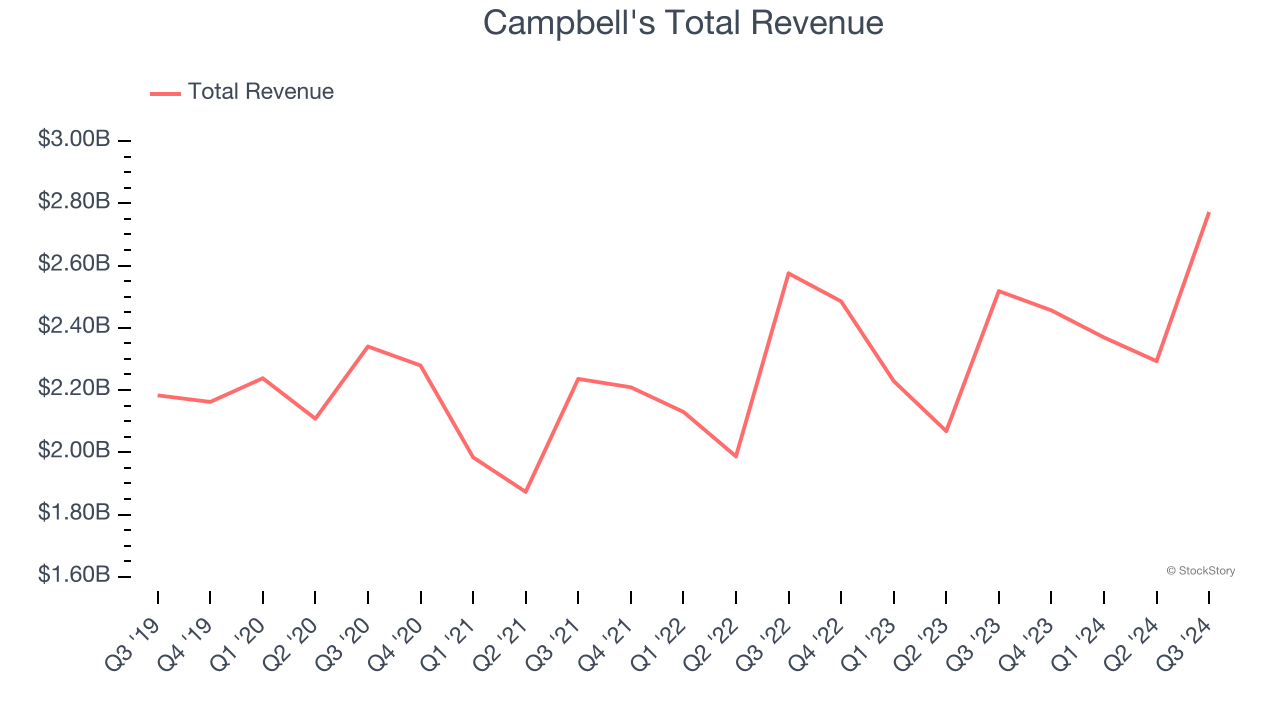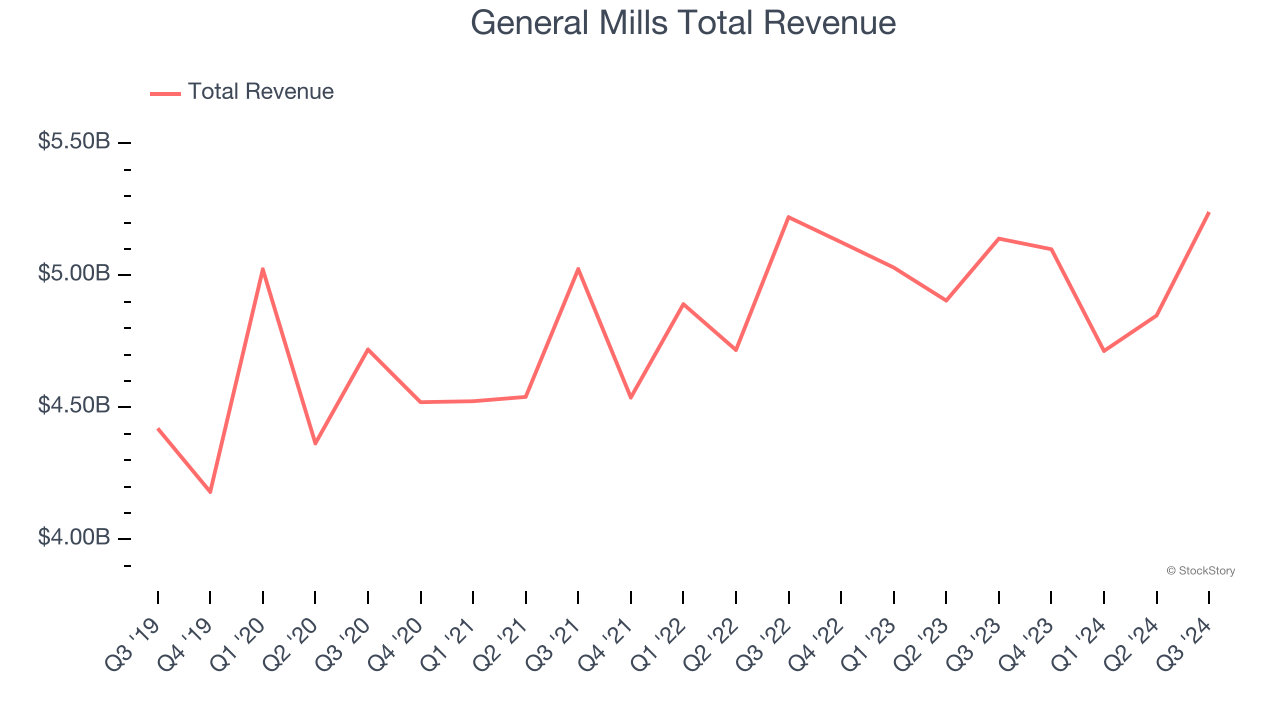
Quarterly earnings results are a good time to check in on a company’s progress, especially compared to its peers in the same sector. Today we are looking at Campbell's (NASDAQ: CPB) and the best and worst performers in the shelf-stable food industry.
As America industrialized and moved away from an agricultural economy, people faced more demands on their time. Packaged foods emerged as a solution offering convenience to the evolving American family, whether it be canned goods or snacks. Today, Americans seek brands that are high in quality, reliable, and reasonably priced. Furthermore, there's a growing emphasis on health-conscious and sustainable food options. Packaged food stocks are considered resilient investments. People always need to eat, so these companies can enjoy consistent demand as long as they stay on top of changing consumer preferences. The industry spans from multinational corporations to smaller specialized firms and is subject to food safety and labeling regulations.
The 21 shelf-stable food stocks we track reported a mixed Q3. As a group, revenues were in line with analysts’ consensus estimates while next quarter’s revenue guidance was 5.7% below.
Amidst this news, share prices of the companies have had a rough stretch. On average, they are down 11.6% since the latest earnings results.
Campbell's (NASDAQ: CPB)
With its iconic canned soup as its cornerstone product, Campbell's (NASDAQ: CPB) is a packaged food company with an illustrious portfolio of brands.
Campbell's reported revenues of $2.77 billion, up 10.1% year on year. This print fell short of analysts’ expectations by 1.1%. Overall, it was a mixed quarter for the company with a decent beat of analysts’ EPS estimates but a miss of analysts’ organic revenue estimates.

Unsurprisingly, the stock is down 14.4% since reporting and currently trades at $38.99.
Read our full report on Campbell's here, it’s free.
Best Q3: General Mills (NYSE: GIS)
Best known for its portfolio of powerhouse breakfast cereal brands, General Mills (NYSE: GIS) is a packaged foods company that has also made a mark in cereals, baking products, and snacks.
General Mills reported revenues of $5.24 billion, up 2% year on year, outperforming analysts’ expectations by 1.9%. The business had a very strong quarter with a solid beat of analysts’ EBITDA estimates and an impressive beat of analysts’ gross margin estimates.

Although it had a fine quarter compared to its peers, the market seems unhappy with the results as the stock is down 10.5% since reporting. It currently trades at $58.96.
Is now the time to buy General Mills? Access our full analysis of the earnings results here, it’s free.
Weakest Q3: Lamb Weston (NYSE: LW)
Best known for its Grown in Idaho brand, Lamb Weston (NYSE: LW) produces and distributes potato products such as frozen french fries and mashed potatoes.
Lamb Weston reported revenues of $1.60 billion, down 7.6% year on year, falling short of analysts’ expectations by 4.3%. It was a disappointing quarter as it posted full-year revenue guidance missing analysts’ expectations.
Lamb Weston delivered the weakest performance against analyst estimates and weakest full-year guidance update in the group. As expected, the stock is down 23.1% since the results and currently trades at $60.11.
Read our full analysis of Lamb Weston’s results here.
J. M. Smucker (NYSE: SJM)
Best known for its fruit jams and spreads, J.M Smucker (NYSE: SJM) is a packaged foods company whose products span from peanut butter and coffee to pet food.
J. M. Smucker reported revenues of $2.27 billion, up 17.2% year on year. This result was in line with analysts’ expectations. It was a strong quarter as it also recorded a solid beat of analysts’ EBITDA and organic revenue estimates.
The stock is down 10.6% since reporting and currently trades at $101.66.
Read our full, actionable report on J. M. Smucker here, it’s free.
Kraft Heinz (NASDAQ: KHC)
The result of a 2015 mega-merger between Kraft and Heinz, Kraft Heinz (NASDAQ: KHC) is a packaged foods giant whose products span coffee to cheese to packaged meat.
Kraft Heinz reported revenues of $6.38 billion, down 2.8% year on year. This number missed analysts’ expectations by 0.6%. Zooming out, it was a mixed quarter as it also recorded full-year EPS guidance slightly topping analysts’ expectations.
The stock is down 17.4% since reporting and currently trades at $28.76.
Read our full, actionable report on Kraft Heinz here, it’s free.
Market Update
Thanks to the Fed's series of rate hikes in 2022 and 2023, inflation has cooled significantly from its post-pandemic highs, drawing closer to the 2% goal. This disinflation has occurred without severely impacting economic growth, suggesting the success of a soft landing. The stock market has thrived in 2024, spurred by recent rate cuts (0.5% in September and 0.25% each in November and December), and a notable surge followed Donald Trump's presidential election win in November, propelling indices to historic highs. Nonetheless, the outlook for 2025 remains clouded by the pace and magnitude of future rate cuts as well as potential changes in trade policy and corporate taxes once the Trump administration takes over. The path forward is marked by uncertainty.
Want to invest in winners with rock-solid fundamentals? Check out our Top 5 Growth Stocks and add them to your watchlist. These companies are poised for growth regardless of the political or macroeconomic climate.
Join Paid Stock Investor Research
Help us make StockStory more helpful to investors like yourself. Join our paid user research session and receive a $50 Amazon gift card for your opinions. Sign up here.




